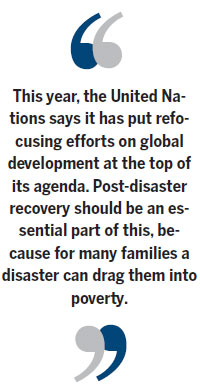Expo pavilions show pain of disaster recovery
Updated: 2015-06-05 06:01
By Fu Jing(China Daily Europe)
|
|||||||||||
Quake-ravaged Nepal and Haiti remind the world of the need to rebuild these nations
After the success of the 2010 Shanghai Expo, the city of Milan offers an amazing stage for countries to showcase their architectural design, national strength and development strategies, all under the theme of "How to feed 9 billion people by 2050".
Filled with tremendously innovative ideas, high-tech animation, interactive displays and delicious food, I can highly recommend the pavilions of Germany, Britain, Italy, South Korea, Japan and China after indulging in the six-month Milan Expo for two days.
In addition to those enlightening hours, however, I felt distress after talking with managers at the pavilions of Nepal and Haiti, both of which have been rocked by devastating earthquakes, Nepal in April and Haiti in 2010.
Wandering the 3-kilometer axis, lined with pavilions on both sides, I saw the flag of Nepal at half-mast. I can understand why, after the death of about 6,000 people in an earthquake in April, the country is in no mood to join the celebrations at the world expo.

Although unfinished, the Nepal pavilion still highlights the country's beautiful religious architecture and design. A donation box stands just a few steps from the flagpole, behind which sat two weary-looking Nepalese. I could not help but follow other visitors in showing my sincere sympathy.
Almost seven years ago, an earthquake shook my home province of Sichuan, which gave me an understanding of the great loss and sorrow they must be feeling.
Middle-aged Rabi Shrestha, one of only three people left running the Nepal pavilion, said 12 of his colleagues had returned to help with rescue and reconstruction work. He said he felt a little relieved that, every day, most visitors demonstrated their love with a donation.
Saying goodbye, I returned to the axis area where I soon spotted an even bigger glass donation box for victims of the Nepal earthquake, where passers-by were putting in handfuls of notes and coins. At that moment, I gave a thumbs-up to Italy, the expo host.
Walking on, I saw a sign for the Haiti pavilion, which is more than 1 km from that of Nepal, and I stepped inside.

The showroom is no bigger than a classroom, and on the shelves are agricultural specialties and handicrafts. Beside the counter sat two Haiti pavilion managers, both of whom shook their heads when I asked about the progress of reconstruction. Even the work to rebuild the presidential building is unfinished after five years, they said.
The problem, they said, was a lack of efficient coordination. With more than 6,000 international organizations in Haiti, the people had been told that donations of billions of dollars were on the way, but some of that aid did not arrive. They said they admired China for its leadership in reconstructing Sichuan after the earthquake in 2008.
After visiting these two pavilions, and those of Cuba and Sudan, I realized the Milan Expo also showcases, to some extent, the stark disparities in the world and the failures in international leadership.
This year, the United Nations says it has put refocusing efforts on global development at the top of its agenda. Post-disaster recovery should be an essential part of this, because for many families a disaster can drag them into poverty.
The sharp contrast in the recoveries of Nepal, Haiti, China and Japan, all of which have suffered severe earthquakes in the past decade, should remind the international community to go beyond fund-raising to helping to quickly implement action plans on the ground.
At least the renewed global efforts should start by preventing Haiti's story from being repeated in Nepal.
The author is China Daily chief correspondent in Brussels. Contact the writer at fujing@chinadaily.com.cn
(China Daily European Weekly 06/05/2015 page12)
Today's Top News
65 bodies found, more than 370 still missing
Ex-FIFA executive detailed bribes in 2013 secret guilty plea
Beijing 'shocked' at Nazi comparison by Philippines
Ship disaster in Yangtze River: Roundup of updates
HK economy will suffer if reform fails, tycoon says
Blatter rocks world soccer by quitting FIFA amid scandal
Obama signs bill remaking NSA phone records program
China's Dalian Wanda buys Australian cinema chain Hoyts
Hot Topics
Lunar probe , China growth forecasts, Emission rules get tougher, China seen through 'colored lens', International board,
Editor's Picks

|

|

|

|

|

|






